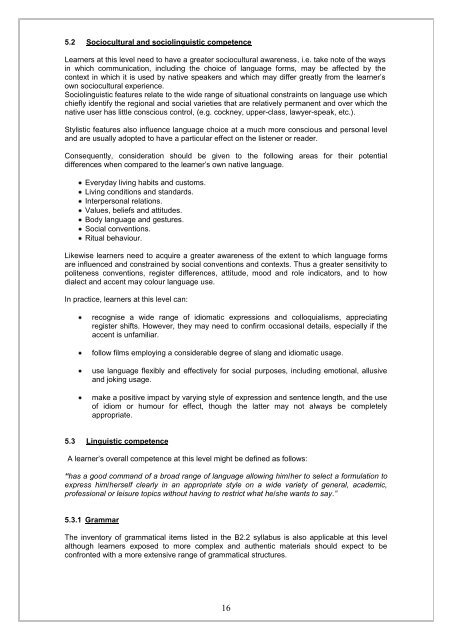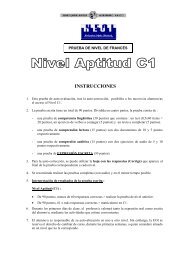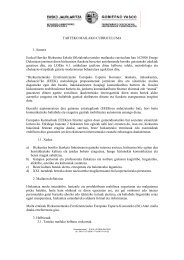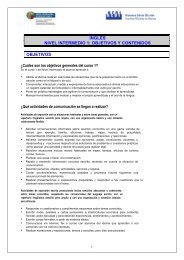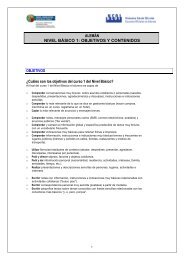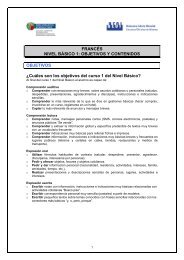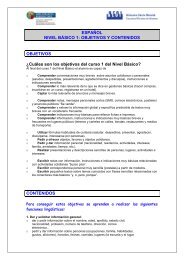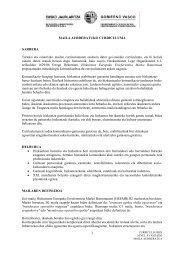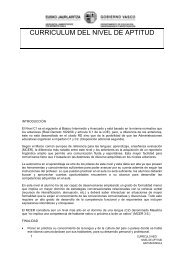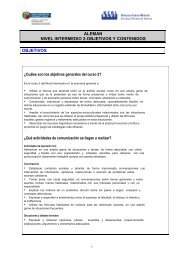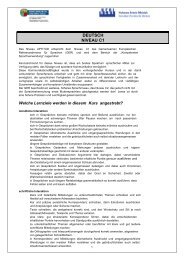C1 – Course Syllabus - Escuelas Oficiales de Idiomas del País Vasco
C1 – Course Syllabus - Escuelas Oficiales de Idiomas del País Vasco
C1 – Course Syllabus - Escuelas Oficiales de Idiomas del País Vasco
You also want an ePaper? Increase the reach of your titles
YUMPU automatically turns print PDFs into web optimized ePapers that Google loves.
5.2 Sociocultural and sociolinguistic competence<br />
Learners at this level need to have a greater sociocultural awareness, i.e. take note of the ways<br />
in which communication, including the choice of language forms, may be affected by the<br />
context in which it is used by native speakers and which may differ greatly from the learner‟s<br />
own sociocultural experience.<br />
Sociolinguistic features relate to the wi<strong>de</strong> range of situational constraints on language use which<br />
chiefly i<strong>de</strong>ntify the regional and social varieties that are relatively permanent and over which the<br />
native user has little conscious control, (e.g. cockney, upper-class, lawyer-speak, etc.).<br />
Stylistic features also influence language choice at a much more conscious and personal level<br />
and are usually adopted to have a particular effect on the listener or rea<strong>de</strong>r.<br />
Consequently, consi<strong>de</strong>ration should be given to the following areas for their potential<br />
differences when compared to the learner‟s own native language.<br />
Everyday living habits and customs.<br />
Living conditions and standards.<br />
Interpersonal relations.<br />
Values, beliefs and attitu<strong>de</strong>s.<br />
Body language and gestures.<br />
Social conventions.<br />
Ritual behaviour.<br />
Likewise learners need to acquire a greater awareness of the extent to which language forms<br />
are influenced and constrained by social conventions and contexts. Thus a greater sensitivity to<br />
politeness conventions, register differences, attitu<strong>de</strong>, mood and role indicators, and to how<br />
dialect and accent may colour language use.<br />
In practice, learners at this level can:<br />
recognise a wi<strong>de</strong> range of idiomatic expressions and colloquialisms, appreciating<br />
register shifts. However, they may need to confirm occasional <strong>de</strong>tails, especially if the<br />
accent is unfamiliar.<br />
follow films employing a consi<strong>de</strong>rable <strong>de</strong>gree of slang and idiomatic usage.<br />
use language flexibly and effectively for social purposes, including emotional, allusive<br />
and joking usage.<br />
make a positive impact by varying style of expression and sentence length, and the use<br />
of idiom or humour for effect, though the latter may not always be completely<br />
appropriate.<br />
5.3 Linguistic competence<br />
A learner‟s overall competence at this level might be <strong>de</strong>fined as follows:<br />
“has a good command of a broad range of language allowing him/her to select a formulation to<br />
express him/herself clearly in an appropriate style on a wi<strong>de</strong> variety of general, aca<strong>de</strong>mic,<br />
professional or leisure topics without having to restrict what he/she wants to say.”<br />
5.3.1 Grammar<br />
The inventory of grammatical items listed in the B2.2 syllabus is also applicable at this level<br />
although learners exposed to more complex and authentic materials should expect to be<br />
confronted with a more extensive range of grammatical structures.<br />
16


